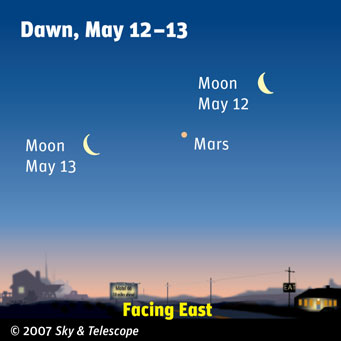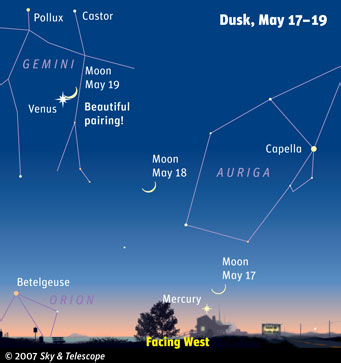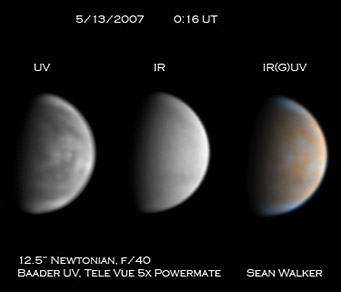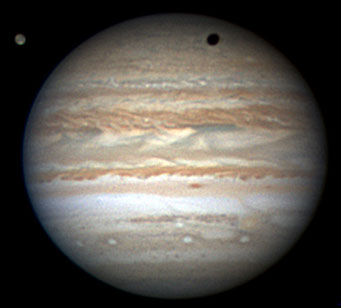Some daily events in the changing sky for May 11 – 19.

If you're an early riser, you can use the Moon to find your way to an early sighting of Mars — which will blaze at opposition in the evening sky next Christmas. (These scenes are drawn for the middle of North America. European observers: move each Moon symbol a quarter of the way toward the one for the previous date.)
Sky & Telescope diagram.
Friday, May 11
The waning crescent Moon points the way to Mars low in the dawn on Saturday and Sunday mornings, as shown here.
Saturday, May 12
It's May, so the Big Dipper is floating upside down at its highest in the north after dark. Face north and look for it almost straight up.
Sunday, May 13
Right around nightfall at this time of year, Vega shines at the same height in the northeast as Capella does in the northwest. These are the brightest stars in the May evening sky — along with Arcturus very high in the southeast.
Monday, May 14
A small telescope will always show Titan, Saturn's largest moon. This evening and tomorrow evening Titan is three or four ring-lengths to Saturn's west. A guide to all of Saturn's satellites visible in amateur scopes is in the May Sky & Telescope, page 51.
Tuesday, May 15
How many galaxies have you seen with binoculars? Under the handle of the Big Dipper are four you can try for using Gary Seronik's Binocular Highlight chart in the May Sky & Telescope, page 44. It's much easier to see such faint targets if you mount your binoculars or image-stabilize them; here's a cheap and easy way to do so.
Wednesday, May 16
New Moon (exact at 3:27 p.m. Eastern Daylight Time).
Thursday, May 17
A twilight challenge: while the sky is still fairly bright, scan just above the west-southwest horizon for the eerily thin crescent Moon above little Mercury, as shown below. Don't look too late or they'll have already set. Binoculars will help.
Friday, May 18
The thin Moon shines lower right of Venus this evening, as shown below. Far below the Moon, can you spot Mercury? It's getting higher every day.
Saturday, May 19
Venus pairs up with the crescent Moon to create a head-turning spectacle high in the west during twilight, as shown below. Venus and the Moon will appear less than 2° apart for viewers throughout North America. Tell family and friends about this one! And use the illustration here to point out Pollux, Castor, and Capella too.

Watch the waxing crescent Moon march up day by day to a spectacular conjunction with Venus on the 19th. This scene is drawn for the middle of North America. European observers: move each Moon symbol a quarter of the way toward the one for the previous date. For clarity, the Moon is drawn three times its actual apparent size.
Sky & Telescope diagram
Want to become a better amateur astronomer? Learn your way around the constellations. They're the key to locating everything fainter and deeper to hunt with binoculars or a telescope. For an easy-to-use constellation guide covering the whole evening sky, use the big monthly foldout map in each issue of Sky & Telescope, the essential magazine of astronomy. Or download our free Getting Started in Astronomy booklet (which only has bimonthly maps).
Once you get a telescope, to put it to good use you'll need a detailed, large-scale sky atlas (set of maps; the standard is Sky Atlas 2000.0) and good deep-sky guidebooks (such as Sky Atlas 2000.0 Companion or the enchanting though dated Burnham's Celestial Handbook). Read here how to use them most effectively.
More beginners' tips: "How to Start Right in Astronomy".
This Week's Planet Roundup
Mercury (about magnitude –1) is becoming visible low in the sunset, getting easier every day. About 45 minutes after the Sun goes down, look for it just over the west-northwest horizon, far to the lower right of Venus.
Look also for fainter Aldebaran left of Mercury at the beginning of the week; lower left of it later in the week. And high above Mercury is Beta Tauri.

Sky & Telescope's Sean Walker continues his Venus imaging as the planet slowly enlarges and wanes. As usual, its clouds were full of detail in the ultraviolet last Saturday evening (May 13th Universal Time) — and, for a change, the seeing was good enough for a few near-infrared details to show as well. Walker made the color rendition by showing ultraviolet as blue, infrared as red, and adding a green channel created by interpolating between the two.
S&T: Sean Walker
Venus (magnitude –4.2, in Gemini) is the brilliant "Evening Star" in the west during and after twilight. This month Venus is at its peak evening height for the year.
Above Venus are Pollux and Castor. Watch them slide down toward the bright planet day by day. A telescope will show that Venus is nearing its half-lit phase, while enlarging a little week by week.
Mars (magnitude +0.9, in Pisces) is still low in the east-southeast during dawn. Though it remains pathetically tiny for now — a mere 5.5 acrseconds in apparent diameter, a featureless little blob in most scopes — be patient. Earth isd catching up to Mars in our faster orbit around the Sun. When we pass it this December, Mars will appear nearly 16
e. That still won't be very large, however; Mars was 25
e around its opposition in August 2003.

This isn't a Hubble photo; it was taken from the ground by an amateur using an 11-inch telescope, video camera, and the frame-stacking technique. Christopher Go has not only mastered the entire process, he benefits from his low latiitude of 10° north (in Cebu, Philippines) where Jupiter passes not far from overhead. Note the detail on slightly gibbous Ganymede at upper left and the noncircular shape of Ganymede's shadow projected onto Jupiter's slanted surface near the limb. The reddish Oval BA (Red Spot Junior) it at lower right, with a red ring outlining a lighter center. The festoon activity in the Equatorial Zone shows weird variety. "The NEB [North Equatorial Belt] is still very busy with a lot of rift activity," Go writes. "There is a new bright white spot above the NTB [North Temperate Belt] just after [following; right of] the central meridian. Note the NTB is turning red like the NEB!" North is up. Click image for even more impressive view.
Christopher Go
Jupiter (magnitude –2.5, in southern Ophiuchus) rises in the east-southeast around 10 p.m. daylight saving time and dominates the south in the early-morning hours.
Antares, less bright, sparkles 9° to Jupiter's right in the evening, and to its lower right before dawn.
Saturn (magnitude +0.4, at the Leo-Cancer border) shines high in the southwest to west during evening.
Regulus, less bright at magnitude +1.4, is 11° to Saturn's left or upper left. North of Regulus is 2nd-magnitude Algieba (Gamma Leonis), a fine telescopic double star, clear yellow.
Uranus (magnitude 6, in Aquarius) is low in the east-southeast before dawn, upper right of Mars.
Neptune (magnitude 8, in Capricornus) is in the southeast just before dawn.
Pluto (magnitude 14, in northwestern Sagittarius) is not far from Jupiter in the south during the early morning hours.
All descriptions that relate to your horizon — including the words up, down, right, and left — are written for the world's midnorthern latitudes. Descriptions that also depend on longitude (mainly Moon positions) are for North America. Eastern Daylight Time (EDT) equals Universal Time (UT, UTC, or GMT) minus 4 hours.
To always get the up-to-date Sky at a Glance, bookmark this URL:
http://SkyandTelescope.com/observing/ataglance .



 0
0

Comments
You must be logged in to post a comment.